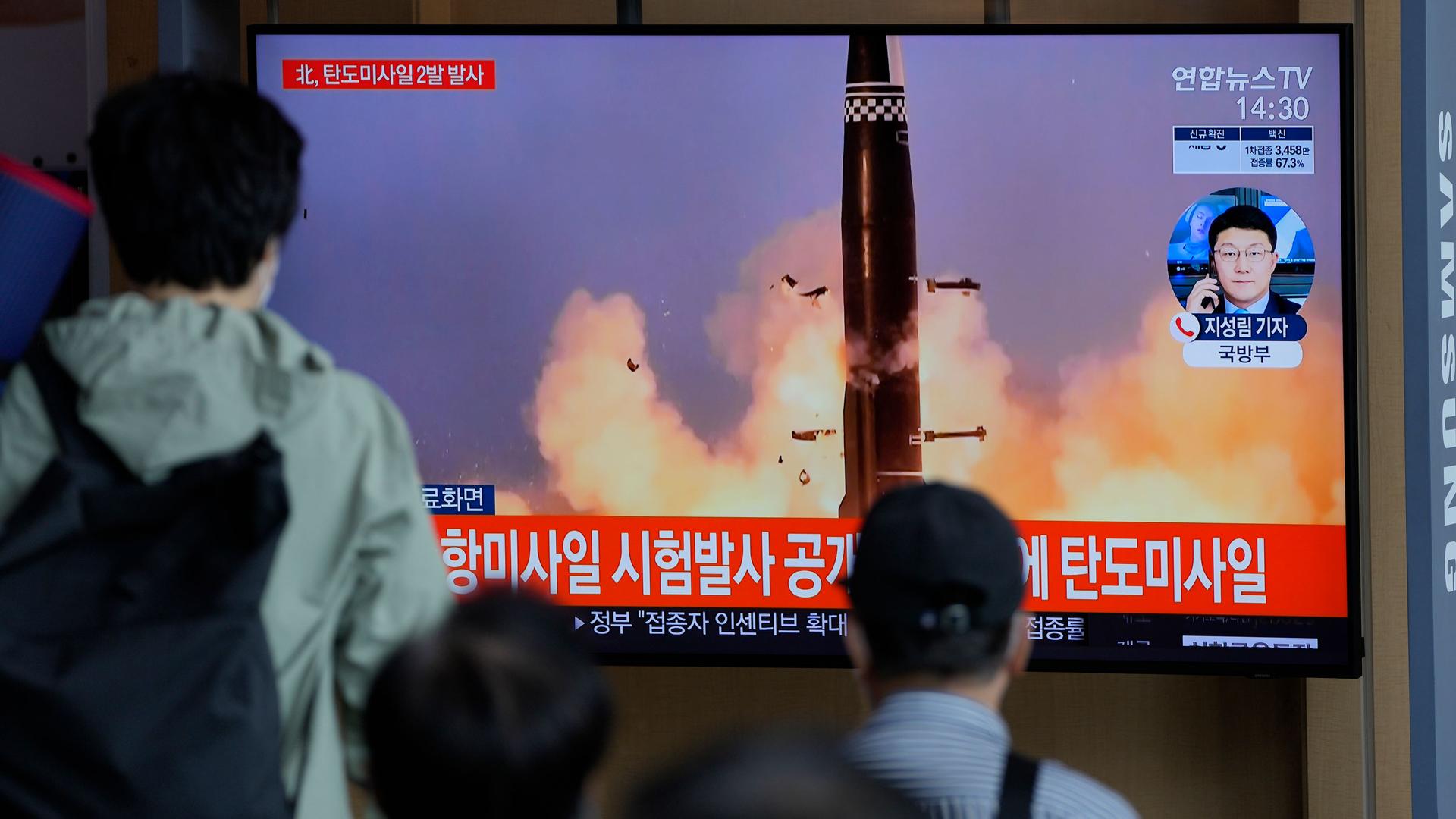Rival Koreas test missiles hours apart, raising tensions
People watch a TV screen showing a news program reporting about North Korea’s missiles with file image in Seoul, South Korea, Sept. 15, 2021.
North and South Korea each tested ballistic missiles on Wednesday, just hours apart, in a display that is sure to exacerbate tensions on the peninsula at a time when talks aimed at stripping the North of its nuclear program are stalled.
South Korea’s presidential office said the country conducted its first submarine-launched ballistic missile test. It said the domestically built missile flew from a submarine and hit its designated target while President Moon Jae-in and other top officials looked on.
Moon said improvements in the country’s missile capabilities would serve as “a sure deterrence against North Korean provocation.”
Earlier Wednesday, North Korea fired two short-range ballistic missiles into the sea. Those launches came two days after the North said it fired a newly developed cruise missile, its first weapons test in six months.
Experts say the North Korea is building up its weapons systems to apply pressure on the United States in the hopes of winning relief from sanctions aimed at forcing the North to abandon its nuclear arsenal. US-led talks on the issue have been stalled for more than two years — and in the meantime, tensions have been rising on the Korean Peninsula.
“North Korea is trying to communicate a message that things will not go as Washington wishes, if it doesn’t accept the North’s demands,” said Moon Seong Mook, an analyst with the Seoul-based Korea Research Institute for National Strategy. He said North Korea may think it has an opportunity now to win concessions from US President Joe Biden’s administration while it is embroiled in a domestic debate following the chaotic pullout from Afghanistan.
Meanwhile, observers say Moon’s government, which has been actively pursuing reconciliation with North Korea, may have taken action to appear tougher in response to criticism that it’s too soft on the North.
The rival nations are still technically in a state of war since the 1950-53 Korean War, which pitted the North and ally China against the South and US-led UN forces, ended in an armistice, not a peace treaty.
Japanese Prime Minister Yoshihide Suga said the launches “threaten the peace and safety of Japan and the region and are absolutely outrageous.” The US Indo-Pacific Command said the move “highlights the destabilizing impact of (North Korea’s) illicit weapons program” though it said it didn’t pose an immediate threat to the US.
The South Korean test will likely infuriate the North, which has often accused its rival of hypocrisy for introducing modern weapons while calling for talks between the divided countries.
South Korea’s military said the North Korean ballistic missiles flew about 800 kilometers (500 miles) before landing in the waters between the Korean Peninsula and Japan. The launches represent a violation of UN Security Council resolutions that bar North Korea from engaging in any ballistic missile activity. But the council typically doesn’t impose new sanctions when the North launches short-range missiles, like Wednesday’s.
Wednesday’s tests came as Chinese Foreign Minister Wang Yi was in Seoul for meetings with Moon and other senior officials to discuss North Korea and other issues.
It’s unusual for North Korea to make provocative launches when China, its last major ally and biggest aid provider, is engaged in a major diplomatic event. But some experts say North Korea may have used the timing to draw extra attention.
Kim Dong-yub, a professor at the University of North Korean Studies in Seoul, said Wednesday’s tests appeared to be of an improved version of a short-range missile it tested in March. He said the weapon is likely modeled on Russia’s Iskander missile, whose flattened-out low altitude flight makes it hard to intercept.
The international community is bent on getting the North to abandon its nuclear program and has long used a combination of the threat of sanctions and the promise of economic help to try to influence the North. But nuclear talks between the United States and North Korea have stalled since 2019, when then-US President Donald Trump’s administration rejected the North’s demand for major sanctions relief in exchange for dismantling an aging nuclear facility.
North Korea leader Kim Jong-un’s government has so far rejected the Biden administration’s overtures for dialogue, demanding that Washington abandon what it calls “hostile” policies first. But the North has maintained its self-imposed moratorium on nuclear and long-range missile tests, a sign that it may not want to completely scuttle the possibility of reopening the talks.
In 2017, North Korea claimed to have acquired the ability to strike the American mainland with nuclear weapons after conducting three intercontinental ballistic missile tests and its most powerful nuclear test. In recent years, it’s also performed a series of underwater-launched missile tests in what experts say is a worrying development because such weapons are difficult to detect in advance and would provide the North with a second, retaliatory strike capability.
South Korea, which doesn’t have nuclear weapons, is under the protection of the US “nuclear umbrella,” which guarantees a devastating American response in the event of an attack on its ally. But South Korea has been accelerating efforts to build up its conventional arms, including developing more powerful missiles.
Experts say the South’s military advancements are aimed at improving its capacity for preemptive strikes and destroying key North Korean facilities and bunkers.
Separate from the submarine-launched missile, South Korea also tested a missile from an aircraft.
By Hyung-Jin Kim and Kim Tong-Hyung/AP
